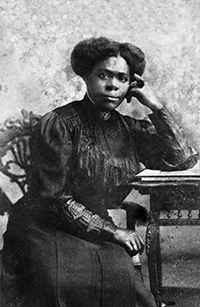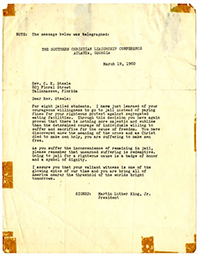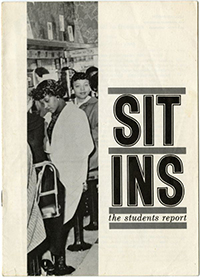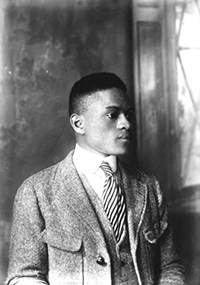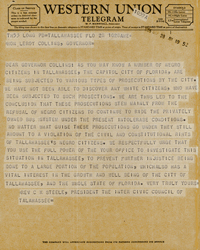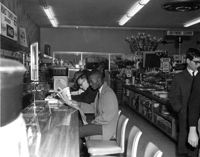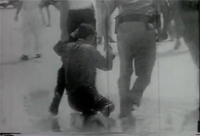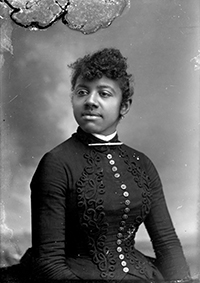Black History Month
Resources for Students and Educators
In 1926, Dr. Carter G. Woodson began officially commemorating African American history during an annual week of remembrance. Woodson promoted the observance of “Negro History Week” during the second week of February to coincide with the birthdays of Frederick Douglass and Abraham Lincoln.
Woodson was one of the first academically trained African American historians in the United States. Through his efforts to celebrate and study the nation's African American heritage, February is now officially designated as Black History Month.
The list below features resources on African American history from the collections of the State Library and Archives of Florida. Black history in Florida is especially rich, dating back to the early 16th century. These resources attest to the struggles and triumphs of persons of African descent in Florida history.
Teachers should review the materials before presenting them to students. Materials on the Florida Memory website have been provided for historical research and educational purposes. The content of some material may be considered sensitive.
Resources: By Topic
Mary McLeod Bethune
-
Mary McLeod Bethune, Educator (Educational Unit)
This educational unit focuses on the life and work of Mary McLeod Bethune, who founded the Daytona Normal and Industrial School for Negro Girls, now Bethune-Cookman College, in Daytona Beach. -
Mary McLeod Bethune
(Selected Documents)
Selected documents related to Mary McLeod Bethune.
Zora Neale Hurston
- Zora Neale Hurston, the WPA in Florida, and the Cross City Turpentine Camp (Educational Unit)
This learning unit focuses on Hurston’s work with the WPA in Florida. - Zora Neale Hurston, 1891-1960 (Audio)
In 1938 and 1939, during the Great Depression, Hurston worked as a folklorist and contributor to the Florida division of the Federal Writers' Project (FWP), part of the Works Progress Administration. Through her work with the FWP, Hurston captured stories, songs, traditions and histories from African-Americans in small communities across Florida.
Civil Rights
- Civil Rights Movement in Florida (Classroom)
This unit introduces major themes, events, and individuals in the history of the Civil Rights Movement in Florida using primary sources from the collections of the State Library and Archives of Florida. - Images of the Civil Rights Movement in Florida (Photographs)
These images document civil rights protests and the struggle to integrate buses, stores, theaters and beaches.
Student Activists and CORE
- Miami Interracial Action Institute Summary and Evaluation, 1959 (Selected Documents)
Susan Boden writes about institute members testing Miami lunch counters, movie theaters and public transportation to see if African American Congress of Racial Equality (CORE) members would be served.
- Stephens Sisters Jail-In Papers, 1960 (Collection)
This selection of correspondence from the Patricia Stephens Due Papers documents the historic 49-day "jail-in" at the Leon County Jail in the spring of 1960 by eight students.
- Sit Ins: The Students Report, May 1960 (Selected Documents)
A booklet published by the Congress of Racial Equality with an introduction by Lillian Smith. It consists of six stories written by young people involved with sit-ins and other non-violent demonstrations across the United States. Patricia Stephens Due, a Tallahassee civil rights activist who was jailed for 49 days with seven other students following a sit-in at a Woolworth's lunch counter, tells her story from jail.
- Congress of Racial Equality (CORE) (Blog)
In the summer of 1959, the Congress of Racial Equality (CORE) organized the Miami Interracial Action Institute and taught attendees principles of non-violent direct action to combat inequality in the South. Two attendees, sisters Patricia and Priscilla Stephens, took these principles with them when they returned to Tallahassee for school and formed the Tallahassee chapter of CORE.
Dr. Martin Luther King Jr.
- Dr. Martin Luther King Jr. in Florida (Blog)
Dr. King was directly involved in a series of protests in mid-1964 in St. Augustine.
- Copy of Telegraph from Martin Luther King Jr. to C. K. Steele, March 19, 1960
Copy of telegraph to the eight jailed students from Martin Luther King Jr. via C. K. Steele. King calls the students courageous and tells them that "[g]oing to jail for a righteous cause is a badge of honor and a symbol of dignity." - Dr. Martin Luther King Jr. (Selected Documents)
Selected documents related to Dr. King. - Selma, Alabama Demonstration (Video)
This film contains footage of the March 1965 voter registration demonstrations in Selma, Alabama. Present are Martin Luther King Jr. and other civil rights leaders.
St. Augustine Civil Rights Demonstrations
- St. Augustine Civil Rights Demonstrations (Florida Highway Patrol) (Video)
This film provides extensive footage of the St. Augustine civil rights demonstrations of 1964, including remarks by Martin Luther King Jr.
Tallahassee Bus Boycott
- Tallahassee Bus Boycott, 1956-57 (Primary Source Set)
- Reverend C.K. Steele (Video)
This film features an interview with civil rights leader C.K. Steele at his home in Tallahassee.
Government Response
- Interposition Resolution in Response to Brown v. Board of Education (Exhibits, Florida Highlights)
The Florida Legislature passed this resolution in opposition to the landmark Brown v. Board of Education (1954) ruling, which overturned the notion of “separate but equal” established by Plessy v. Ferguson (1896). - Reports of Investigators on Meetings of the Southern Christian Leadership Conference and the Ku Klux Klan (Exhibits, Florida Highlights)
These documents relate findings by the Johns Committee into issues surrounding the civil rights movement and resistance to integration. - Governor Farris Bryant Addresses Senate Commerce Committee (Video)
In this film, Governor Bryant addresses the Senate Commerce Committee concerning Senate Bill 1732 on the integration of interstate busing.
1970s
- Angela Davis (Video)
This film includes a speech by and interviews with civil rights activist Angela Davis at Florida Agricultural & Mechanical University's (FAMU) Black History Month convocation in 1979. - Vibrations: Julian Bond/Frenchtown/Pitts & Lee March (Video)
In this film, interviewer Lucias Gant talks with Georgia Senator Julian Bond about civil rights issues.
Daily Life
-
Portraits of African Americans from the Alvan S. Harper Collection (1884-1910) (Photographs)
These images represent the teachers, business owners, and local leaders of Tallahassee’s vibrant African American community. - The Forgotten History of Lincolnville (Floridiana Article)
Lincolnville was the center of the black business and residential community in St. Augustine.
- Twine Collection (1922-1927) (Photographs)
Photographs taken by Richard Aloysius Twine of Lincolnville in St. Augustine. -
Interview with Railroader Tom Watson (Audio)
Interviewed in 1988, Watson reflects on his 30 years with the Jacksonville railroad, including civil rights issues, working conditions for African Americans, and integration.
Excerpt from the interview:
Slavery
- Sallie Bradford Slave Register, 1860-1876
This slave register lists the the names and dates of birth of slaves owned by, and freedmen working for, Thomas A. Bradford, with birth dates ranging from 1802-1876. - Distant Storm: Florida’s Role in the Civil War (Exhibits)
This exhibit commemorates the Civil War sesquicentennial, including the history of slavery in Florida. -
Selected Documents (Collections)
Search slave in the Selected Documents collection. -
Florida Freedmen’s Contract, Jefferson County
This document is an example of the work agreements made between planters and freemen in the post-Civil War south; in this case, S.B. Alexander of Jefferson County and 13 African American laborers. -
Kingsley Papers (Collections)
Kingsley was a wealthy planter and slave owner in Northeast Florida during the early 19th century. This collection contains documents relevant to the Kingsley plantation and estate. -
Images of the Zephaniah and Anna Kingsley Plantation (Photographs)
Images of the Kingsley plantation and associated slave quarters built on Fort George Island north of Jacksonville. -
Daniel Wiggins Diary Entry (Exhibits, Florida Highlights)
This document is an excerpt from the diary of Daniel Wiggins, in which, among other topics, he describes slavery in territorial Florida.
Additional Resources at the State Library and Archives
The State Library and Archives of Florida is located on the second floor of the R.A. Gray Building, 500 South Bronough Street, Tallahassee, Florida, two blocks west of the State Capitol. Our public research facilities are open from 9:00 a.m. to 4:30 p.m., Monday through Friday. The State Library and Archives is closed Saturdays, Sundays and on state holidays.
Researchers are encouraged to check with the The State Library and Archives to verify operating hours and records availability prior to visiting. Directions are available in an online map.
Additional Resources at Your Library
If you need additional assistance locating information for your process paper and annotated bibliography, talk to the librarian at your school or public library or use the Ask-a-Librarian service. A librarian can help you locate primary and secondary resources that may not be retrieved using search engines such as Google.

 Listen: The World Program
Listen: The World Program